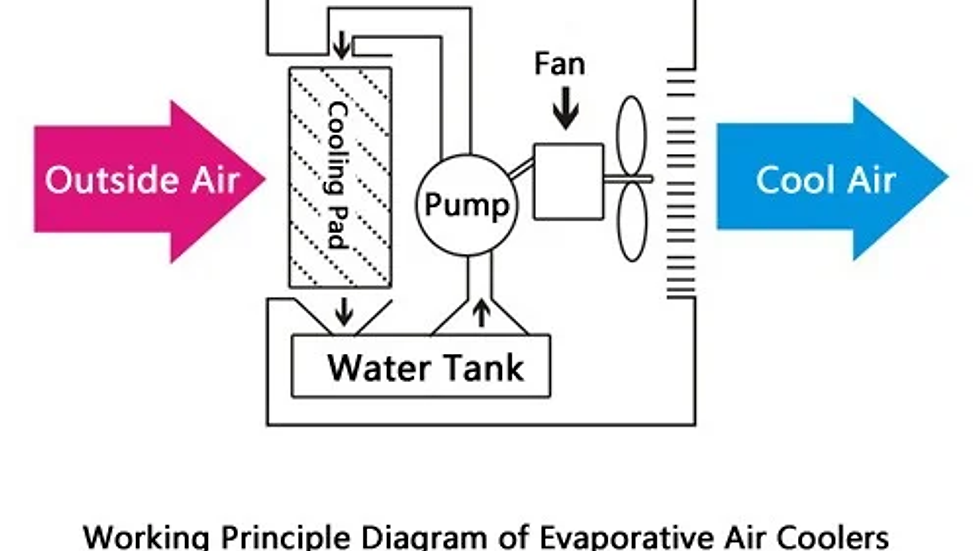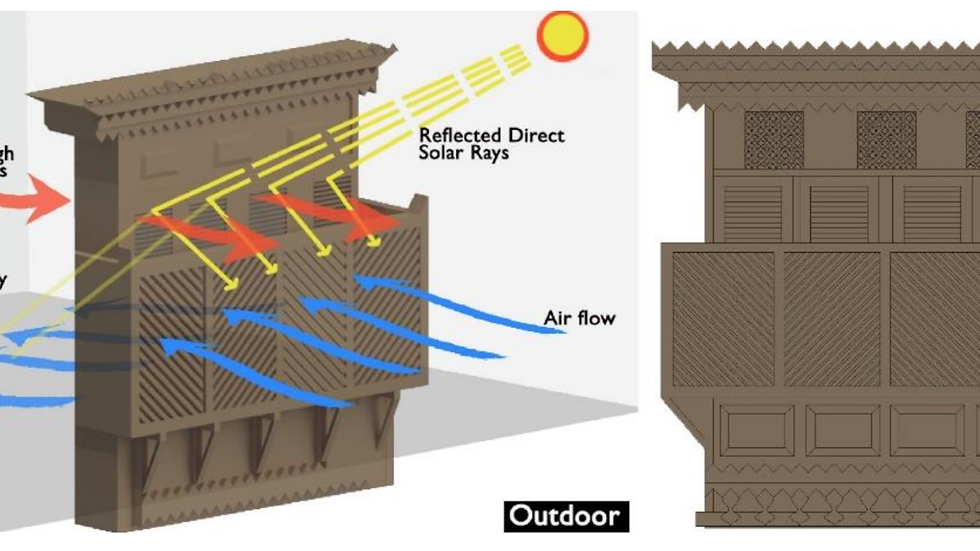🌬️ Embracing Passive Evaporative Cooling for a Sustainable Future
- indrsarv
- Apr 22
- 5 min read
Updated: Oct 31
Passive evaporative cooling works by harnessing the basic principle of water evaporation. When dry air passes over or through water, it absorbs moisture and cools down. This process requires far less energy than conventional air conditioning systems.
Unlike active cooling systems, passive techniques do not rely on compressors or refrigerants. This makes passive cooling a more sustainable and environmentally friendly option.
This technique thrives in hot and dry climates where humidity is low, maximizing the potential of water evaporation. Multiple architectural interventions exist to implement this effective technique.

Examples include wind towers that direct air down over water surfaces and porous clay or earthen walls that retain water, facilitating continuous evaporation.
These solutions combine well with high thermal mass materials that help regulate indoor temperatures. They provide comfort while significantly reducing the urban heat island effect, lowering dependency on fossil fuels, and conserving energy.
Studies show that buildings using evaporative cooling can cut energy consumption by up to 50% compared to those using traditional cooling systems.
In addition to environmental benefits, passive evaporative cooling systems are cost-effective over time. Their implementation encourages innovative design thinking, blending modern architecture with traditional practices.
These systems can be harmoniously integrated into building facades or courtyards, serving as aesthetic features. As climate patterns grow increasingly unpredictable, these systems offer resilience and adaptability, often lacking in high-energy cooling systems.
Such strategies could establish cooler and healthier communities within schools, public buildings, and high-density housing without compromising design aspirations.
🏛️ IIT Gandhinagar: A Living Laboratory
The IIT Gandhinagar campus serves as a prime example of climate-responsive design that utilizes passive cooling strategies. The campus has integrated systems like Passive Downdraft Evaporative Cooling (PDEC), Forced Air Evaporative Cooling (FAEC), and night-time ventilation.
PDEC systems are present in multiple buildings, including classrooms, dining halls, and residence facilities.
These systems operate by drawing hot ambient air through water-cooled downdraft shafts. The air cools through evaporation as it travels downward, ultimately being delivered into occupied zones.
Experimental observations during peak summer months revealed these systems can reduce indoor temperatures by 4–5°C compared to ambient outdoor temperatures.
This improvement enhances thermal comfort while also significantly lowering the demand for mechanical air conditioning.
The design process includes intelligently orienting buildings along the east-west axis to reduce direct solar heat gain. Coupled with operable windows, solar chimneys, and shaded courtyards, the IITGN campus optimizes airflow while minimizing energy use.
Their implementation stems from thorough climate analysis and thermal simulations, reflecting the institution's commitment to sustainability and innovation.
Moreover, the campus functions as a testbed for continuous learning. Performance data is collected and analyzed by students and faculty, contributing to a loop of iterative improvement. This transforms passive cooling from a one-time design choice into an ongoing system of research and development.
Visitors and policymakers are welcomed to experience these innovations firsthand, establishing IIT Gandhinagar as a reference point for sustainable design in educational institutions.
🧱 Design Elements Enhancing Passive Cooling
Design plays a crucial role in maximizing the benefits of passive evaporative cooling. Building orientation is vital. Aligning structures along the east-west axis minimizes the surface area exposed to the sun and reduces heat gain.
Shading devices like overhangs, pergolas, and louvres effectively cut down solar radiation, especially on facades with high sun exposure.
The choice of materials also greatly impacts cooling efficiency. Walls made from adobe, rammed earth, or fly ash-based concrete possess high thermal mass. They regulate temperature fluctuations by absorbing heat during the day and releasing it at night.
For evaporative systems to function efficiently, integrating water features such as fountains, ponds, or misting systems into the landscape or architecture enhances the cooling effect.

Ventilation is another essential design element.
Cross-ventilation is improved through strategically placed windows, courtyards, and atria.
Wind towers and solar chimneys can be added to drive airflow naturally, enhancing passive cooling effectiveness.
Roofs treated with solar-reflective materials or shaded with vegetation further mitigate heat accumulation.
These integrated strategies transform the built environment into a breathable, responsive ecosystem.
Architects are also experimenting with bio-climatic materials like breathable membranes, ventilated double-skin facades, and living walls. These approaches not only facilitate cooling but also filter air, enhancing the visual appeal of spaces.
Whether it’s a residential complex or a corporate office, thoughtful architectural detailing ensures that passive cooling is not only functional but also seamlessly incorporated into the user experience.
🌍 Global Perspectives and Innovations
Throughout the globe, architects are revisiting traditional techniques in response to climate change.
In regions like the Middle East and North Africa, wind catchers and mashrabiya screens historically passively cooled homes. These techniques are now being hybridized with modern materials and technologies to boost efficiency.
For instance, Iran’s traditional wind towers are undergoing digital modeling and optimization for height and aperture, enabling enhanced performance in modern developments.

In Western contexts, innovations such as green roofs, phase change materials (PCMs), and passive cooling bricks are being developed to comply with stringent energy codes and comfort standards.
A notable advancement is the "Cool Brick," a 3D-printed porous ceramic that retains water and promotes evaporation as air passes through it. These bricks hold promise for retrofitting urban façades while maintaining aesthetic integrity.
Additionally, cities like Barcelona and Singapore are integrating district-scale cooling systems that blend both passive and active methodologies. Passive cooling is gaining recognition in LEED and WELL certifications, underscoring its significance in sustainable building practices.
These global examples highlight that passive cooling is not merely a traditional technique—it has become a crucial component of future-ready architecture worldwide.
In South America, especially Brazil, architects draw inspiration from indigenous construction methods that utilize passive airflow through lightweight, permeable materials and stilted foundations.
In the United States, institutions like Arizona State University are testing thermal comfort zones based on passive design tailored for arid conditions. Across the world, these diverse approaches validate the adaptability of passive cooling across various cultural and climatic contexts.
💡 The Future can be Cool and Sustainable
Passive evaporative cooling presents a resilient and low-tech solution to modern energy and climate challenges. As urban populations surge and energy demands rise, passive systems offer relief without the substantial environmental cost.
Not only do they lower electricity consumption, but they also minimize carbon emissions and foster thermal comfort throughout the seasons.
For countries like India and other tropical regions, incorporating these systems into public buildings, housing projects, and communal areas could lead to more livable and inclusive urban environments.
The key lies in climate-conscious design—understanding local weather patterns, utilizing site-specific materials, and collaborating with engineers and architects to tailor the best solutions.
Moreover, education and policy support are essential for broader adoption. Government incentives, revised building codes, and public awareness campaigns can motivate wider implementation of passive cooling strategies.
As the global building sector grapples with decarbonization goals, passive evaporative cooling emerges as an accessible and effective strategy.
To promote this, municipalities must invest in community-level prototypes and demonstration projects. Urban planning authorities can formulate guidelines to encourage developers to consider passive cooling from the foundational stages of design.
Ultimately, cooling cities passively not only relates to energy—it embodies reclaiming our relationship with the climate through responsible design.
📣 Join the Movement
Are you interested in integrating passive cooling strategies into your projects? Explore the possibilities with SARV: Sustainable. Book a complimentary session with our principal architect, Mrugendrasinh Sarvaiya, and discover how your spaces can stay naturally cool and energy-efficient.

Comments